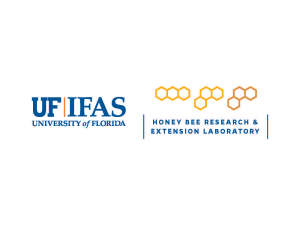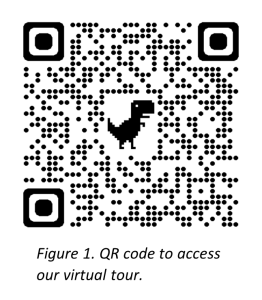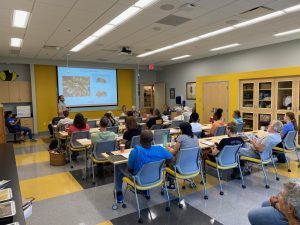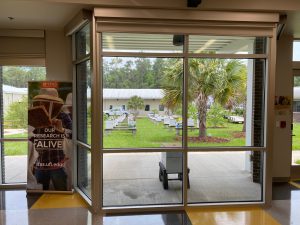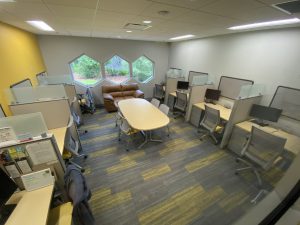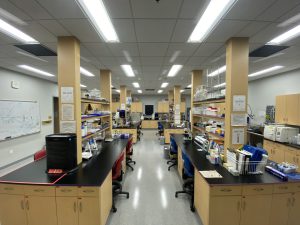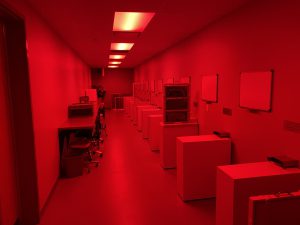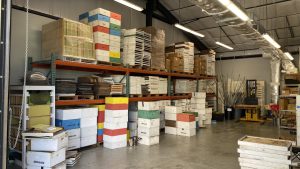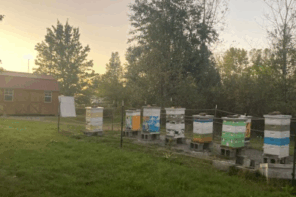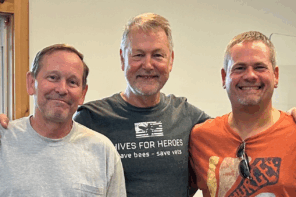From the University of Florida Honey
Bee Research and Extension Laboratory
The University of Florida Honey Bee Laboratory Facilities
By: Chris Oster
January: Overview of the HBREL at UF
February: Honey Bee/Beekeeping Teaching Programs
March: Research on Honey Bees
April: Apiculture Extension (Part 1)
May: Apiculture Extension (Part 2)
June: Roles in a Typical Honey
Bee Lab
July: How Labs are Funded
August: The Lab’s Physical Infrastructure
September: What it Take to Run a Laboratory Effectively
October: Professional Development
in the Lab
November: Members of the HBREL Team and What They Do
December: The HBREL’s Most
Notable Successes/Contributions to the Beekeeping Industry
Hello, my name is Chris Oster. I am the Lab Manager at the University of Florida, Institute of Food and Agricultural Sciences (UF/IFAS), Honey Bee Research and Extension Laboratory (HBREL). The mission of the HBREL is to advance our understanding of managed honey bees in Florida, the U.S. and globally, with a goal of improving the health and productivity of honey bees everywhere. We address this goal by conducting basic and applied research projects on honey bees, communicating our findings to assorted clientele groups through diverse extension programming, and training future generations of bee educators, researchers, conservationists and more. This is our mission statement, which can be found on our website: www.ufhoneybee.com. There you may take a full virtual tour of our facility as well, providing you with a “bee’s-eye view”. Alternately, you can reach the virtual tour by scanning this QR code with your smartphone (Fig. 1) or going to https://mpembed.com/show/?m=8aixQmS5aWn&mpu=493&mpv=1. In this article, I will provide a brief description of the HBREL’s infrastructure which allows us to strive towards our goal.
The new HBREL facility was officially opened on August 24, 2018. It was built through the tireless efforts of the Florida State Beekeepers Association, the Florida State Legislators, the University of Florida, corporate sponsors and supportive beekeepers. Since its opening, members of the HBREL (faculty, staff and students) have been conducting cutting-edge research, hosting award-winning extension programs and teaching hundreds of students about beekeeping and honey bees. To carry out these tasks, a state-of-the-art facility is needed, and that is exactly what we have. I will start with our classroom (Fig. 2).
In many ways, our classroom is exactly what you would expect of a modern classroom: thirty seats, all with electrical outlets for students to charge their laptops, a projector for presentations and a whiteboard. What stands out to many people about our classroom (and the entire facility) is the color scheme. Many of the walls and the floors are accented in “Bee Hive Yellow”. Details like this bring home the point that this facility was built specifically for honey bee research/teaching/extension, down to the most minute detail. My favorite feature of our classroom is what I like to call our reverse bay window (Fig. 3). This floor to ceiling window not only looks over our on-campus apiary containing nearly 50 colonies, but it also is an extremely valuable teaching tool. A beekeeper can give a hive demonstration to a group of people while they are in the classroom gathered around this window. The beekeeper wears a microphone that projects their voice into the classroom, while in the classroom, a microphone can be passed around the visitors so they can ask questions of the beekeeper. This window allows us to take people to beehives who would not get the chance otherwise. Now do not get me wrong, we will take almost anyone into the apiary with us for a hive demonstration, from toddlers to the elderly. But for some, suiting up and standing out in the sun is just not an option. That is why this window is such an amazing resource for teaching and extension.
The next notable room in our facility is our Dutch Gold Honey graduate student and visiting scholar office (Fig. 4). At the time of writing, this room provides personal desk space for three graduate students, one visiting scholar, with two more on the way. Having a permanent personal space is vital for students and researchers alike for conducting data analysis, attending online classes, planning research projects or simply doing homework. Having a space that you can call your own can help to facilitate a more enjoyable and productive working environment. Also, note the hexagonal windows, which when viewed from the outside, make our lab’s logo. These windows serve as another reminder that you are in the HBREL.
Just down the hall from the graduate student and visiting scholar offices is the physical laboratory space (Fig. 5 – David J. Mendes Research Laboratory). As the Lab Manager, this room is my favorite and least favorite place simultaneously. On one hand, it is where much of our research is conducted. I take pride in that. On the other hand, it is my responsibility to make sure everyone in the lab is properly trained in the event of a chemical spill, all the chemicals are being used and stored in a safe manner, all the machinery is calibrated, accurate, and is being used properly and safely, all the freezers and refrigerators are the proper temperature and are defrosted regularly, etc. I could go on, but that article is for next month’s edition, so stay tuned.
All in all, the David J. Mendes Research Laboratory is the heart of the HBREL. For state-of-the-art research, we need a state-of-the-art lab. The main lab area consists of four islands with bench space for four researchers at each island. One island is sectioned off for pesticide research to limit the potential spread to other experiments. One corner of the lab is dedicated to DNA work with another corner dedicated to microscopy. Around the exterior of the lab are four auxiliary rooms. The first contains our emergency eyewash/shower station and our fume hood, which is used if experiments may generate harmful fumes. The second room, the Gamber Container, INC. room, is dedicated to molecular work to keep it separated from traffic and thus free from contaminants. The third room is a USDA APHIS-compliant and permitted room for using imported royal jelly to rear honey bees in vitro. The final auxiliary room of the laboratory is the Florida Farm Bureau Federation freezer, refrigerator and incubator room. In this space, we have three -80°C freezers for preserving DNA, three ordinary refrigerator/freezer combo units for sample storage, a chest freezer, five incubators, and an ethanol grade refrigerator that stores our honey bee collection. This collection has over 80,000 samples of different Apis species and their pests from all over the world. This collection is always expanding as lab members travel the world for teaching, research, and extension and as samples are donated for preservation.
The final room of our main building is the Jester Bee Company observation hive room (Fig. 6). From my research, this room is truly unique. Here, we can set up twelve observation hives, all with access to the outside for research involving honey bee behavior. The hardest part about studying any behavior is minimizing the effects of your observations on the outcome of the experiment (otherwise known as “observer or detection bias”). To mimic conditions in an actual honey bee hive, we have the capabilities to use only red light in this room. Since honey bees cannot see red wavelengths of light, this appears to them like a normal interior of a hive. We can also heat this room independent of the rest of the building to near the optimal hive temperature, mitigating the burden on the bees to thermoregulate in what would be a typical outdoor hive.
While outlining notable features of our main office, I did not even include our three faculty offices (including the Lois La Seur and the Laurence Cutts offices), the four staff offices (including the Peter E. A. Teal memorial office and the Senator Kevin & Rabbi Amy Rader office) capable of seating eight, the Robert L. Steele Family computer lab, or the D&J Apiary break room. These labs, offices, and spaces come together to make the main, but not the only, building of the HBREL. There are two more buildings that make up our overall facility. One is the Gordon Clauss outdoor classroom/teaching pavilion (Fig. 7). This space is used for teaching classes that cannot be taught in a traditional classroom, such as smoker lighting or hive construction. It also comes in handy when you are scheduled to teach a hive demonstration class while it is pouring rain.
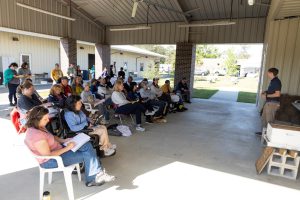
Figure 7. Gordon Clauss outdoor classroom/teaching pavilion during Bee College. Photo credit: UF/IFAS Communications
The final building that makes up the HBREL is very important to the success of our laboratory. The Amy E. Lohman Apiculture Center includes our workshop (Fig. 8) where we store all our beekeeping equipment when it is not in use. We also have a 355-square-foot, walk-in freezer for storing drawn comb that cannot be invaded by ants, roaches and wax moths. Our workshop also has all the necessary woodworking tools one might need to construct beehives or modify them for research purposes.
Adjacent to our workshop is the Dadant honey processing facility (Fig. 9). This room is one of the most impressive spaces we have to offer. It is a fully functional honey extraction and bottling facility which highlights these processes at every scale of beekeeping. We have five extractors: a two-frame hand-powered, a four-frame motorized, a twelve-frame radial, a twenty-frame radial, and an 84-frame radial extractor. Current and prospective beekeepers can come to this facility to learn the journey that honey takes to get from the hive to the bottle. To complete the commercial line, we have an uncapping machine that feeds into our 84-frame extractor. From there, the honey flows through a set of baffles into 1,000-pound storage tanks. The honey can then be pumped through a honey dryer or directly to a bottling machine. This room is mostly used for hands-on extracting classes using a hot knife and our trusty twelve-frame extractor, but hopefully someday soon we can put the commercial line to the test. As a bonus, the honey house meets the requirements to be a commercial kitchen in Florida. Once we receive this designation, any honey bottled in our facility could be sold wholesale.
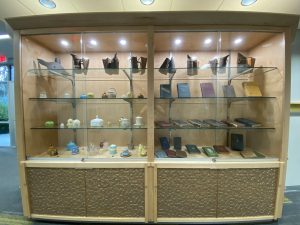
Figure 10. Sample of the Helen and David K. McGinnis Beekeeping Museum display cabinet. Photo credit: Chris Oster
The last room I get to tell you about is the one that most excites me. We are in the process of curating a beekeeping museum to show all the amazing beekeeping antiques that have been donated to the lab. This will be the Helen and David K. McGinnis Beekeeping Museum. We want our facility to be somewhere people can go to learn all aspects of beekeeping, including its history. Some highlights of our current collection include nearly 50 smokers (some of which date back to the 1800s), over 640 editions of Bee Culture Magazine (including Volume 1 Numbers 1-12 published in 1873), over 550 editions of the American Bee Journal dating back to 1948, honey jars, pots and tins that have somehow survived the ages, and many more amazing pieces. Our collection is growing all the time as new pieces are donated. While I cannot show off the museum just yet, Figure 10 is a sneak peek! When it’s completed, we hope to have one of the finest beekeeping museums around.
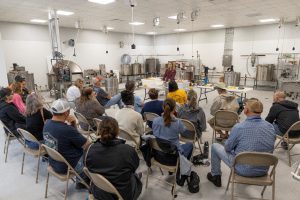
Figure 9. Honey extraction being taught during Bee College in the Dadant Honey Processing Facility. Photo credit: Cat Wofford, UF/IFAS Communications
Hopefully after reading this, you have come to the conclusion that the University of Florida’s Institute of Food and Agricultural Science HBREL is a special place. The HBREL is not only the physical space we occupy, but also includes the staff, students and faculty who work here. We have all the beekeepers who have supported us throughout the years to thank for this incredible space to devote to research, outreach and education. If you are ever in Gainesville, we offer public tours of our lab on the first Wednesday of every month. The sign-up page for this tour can be found on our website, www.ufhoneybee.com.







